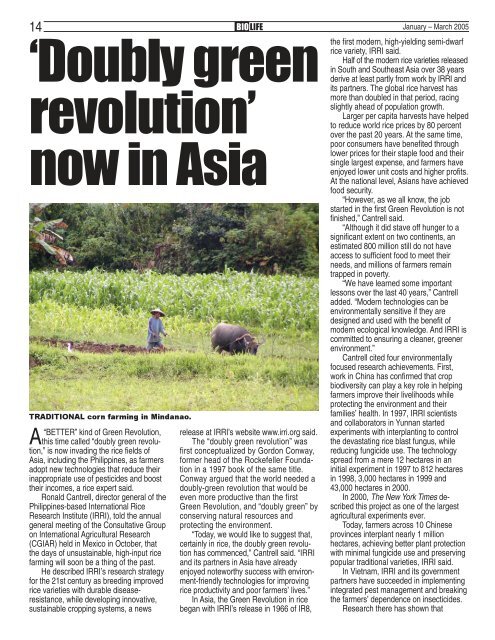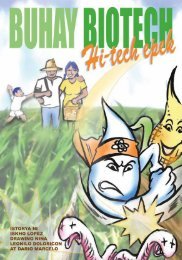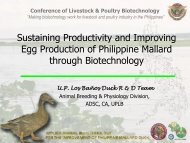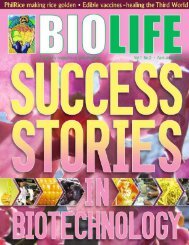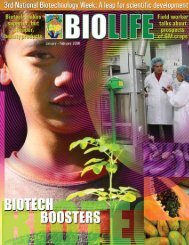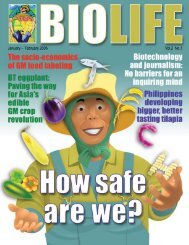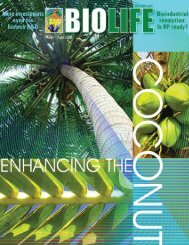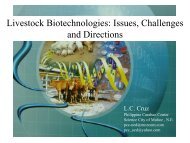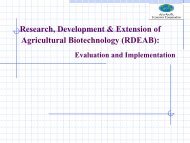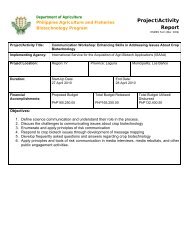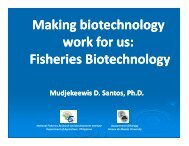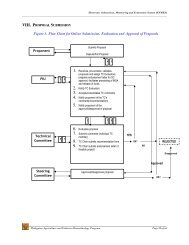Download PDF - SEARCA Biotechnology Information Center
Download PDF - SEARCA Biotechnology Information Center
Download PDF - SEARCA Biotechnology Information Center
You also want an ePaper? Increase the reach of your titles
YUMPU automatically turns print PDFs into web optimized ePapers that Google loves.
14 BIO LIFE January – March 2005<br />
‘Doubly green<br />
revolution’<br />
now in Asia<br />
TRADITIONAL corn farming in Mindanao.<br />
A<br />
“BETTER” kind of Green Revolution, release at IRRI’s website www.irri.org said.<br />
this time called “doubly green revolution,”<br />
The “doubly green revolution” was<br />
is now invading the rice fields of first conceptualized by Gordon Conway,<br />
Asia, including the Philippines, as farmers former head of the Rockefeller Foundation<br />
adopt new technologies that reduce their<br />
in a 1997 book of the same title.<br />
inappropriate use of pesticides and boost Conway argued that the world needed a<br />
their incomes, a rice expert said.<br />
doubly-green revolution that would be<br />
Ronald Cantrell, director general of the even more productive than the first<br />
Philippines-based International Rice<br />
Green Revolution, and “doubly green” by<br />
Research Institute (IRRI), told the annual conserving natural resources and<br />
general meeting of the Consultative Group protecting the environment.<br />
on International Agricultural Research<br />
“Today, we would like to suggest that,<br />
(CGIAR) held in Mexico in October, that certainly in rice, the doubly green revolution<br />
the days of unsustainable, high-input rice<br />
has commenced,” Cantrell said. “IRRI<br />
farming will soon be a thing of the past. and its partners in Asia have already<br />
He described IRRI’s research strategy enjoyed noteworthy success with environment-friendly<br />
for the 21st century as breeding improved<br />
technologies for improving<br />
rice varieties with durable diseaseresistance,<br />
rice productivity and poor farmers’ lives.”<br />
while developing innovative,<br />
In Asia, the Green Revolution in rice<br />
sustainable cropping systems, a news began with IRRI’s release in 1966 of IR8,<br />
the first modern, high-yielding semi-dwarf<br />
rice variety, IRRI said.<br />
Half of the modern rice varieties released<br />
in South and Southeast Asia over 38 years<br />
derive at least partly from work by IRRI and<br />
its partners. The global rice harvest has<br />
more than doubled in that period, racing<br />
slightly ahead of population growth.<br />
Larger per capita harvests have helped<br />
to reduce world rice prices by 80 percent<br />
over the past 20 years. At the same time,<br />
poor consumers have benefited through<br />
lower prices for their staple food and their<br />
single largest expense, and farmers have<br />
enjoyed lower unit costs and higher profits.<br />
At the national level, Asians have achieved<br />
food security.<br />
“However, as we all know, the job<br />
started in the first Green Revolution is not<br />
finished,” Cantrell said.<br />
“Although it did stave off hunger to a<br />
significant extent on two continents, an<br />
estimated 800 million still do not have<br />
access to sufficient food to meet their<br />
needs, and millions of farmers remain<br />
trapped in poverty.<br />
“We have learned some important<br />
lessons over the last 40 years,” Cantrell<br />
added. “Modern technologies can be<br />
environmentally sensitive if they are<br />
designed and used with the benefit of<br />
modern ecological knowledge. And IRRI is<br />
committed to ensuring a cleaner, greener<br />
environment.”<br />
Cantrell cited four environmentally<br />
focused research achievements. First,<br />
work in China has confirmed that crop<br />
biodiversity can play a key role in helping<br />
farmers improve their livelihoods while<br />
protecting the environment and their<br />
families’ health. In 1997, IRRI scientists<br />
and collaborators in Yunnan started<br />
experiments with interplanting to control<br />
the devastating rice blast fungus, while<br />
reducing fungicide use. The technology<br />
spread from a mere 12 hectares in an<br />
initial experiment in 1997 to 812 hectares<br />
in 1998, 3,000 hectares in 1999 and<br />
43,000 hectares in 2000.<br />
In 2000, The New York Times described<br />
this project as one of the largest<br />
agricultural experiments ever.<br />
Today, farmers across 10 Chinese<br />
provinces interplant nearly 1 million<br />
hectares, achieving better plant protection<br />
with minimal fungicide use and preserving<br />
popular traditional varieties, IRRI said.<br />
In Vietnam, IRRI and its government<br />
partners have succeeded in implementing<br />
integrated pest management and breaking<br />
the farmers’ dependence on insecticides.<br />
Research there has shown that


